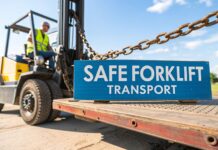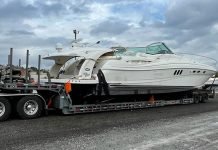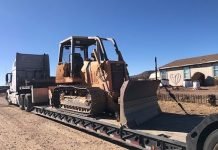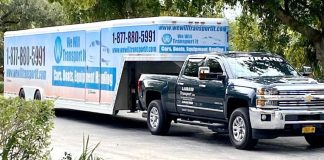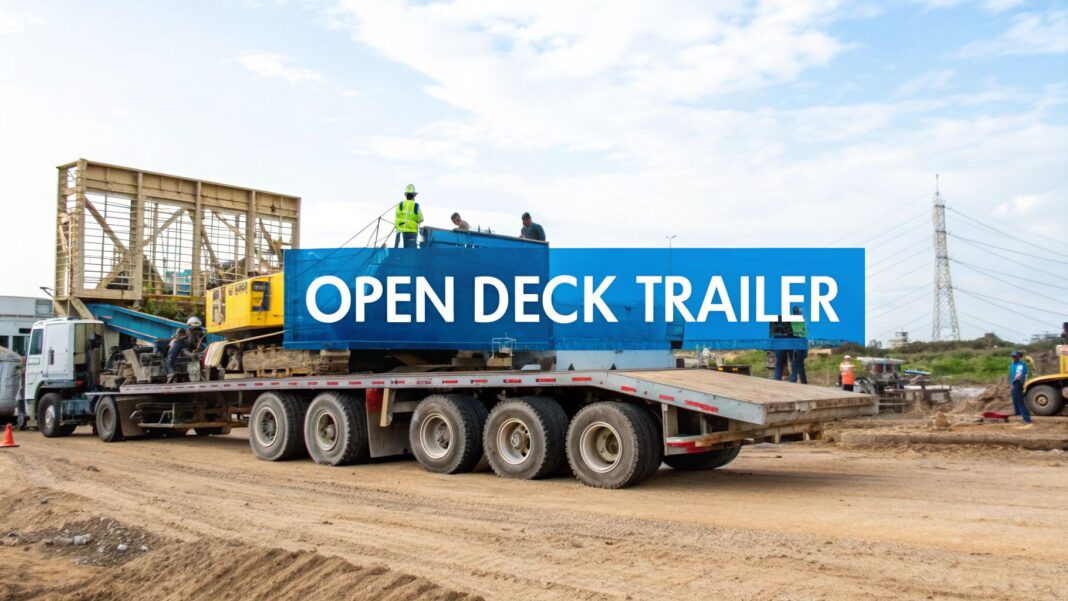
When you need to haul freight, the first image that comes to mind is probably a standard enclosed van trailer. But what happens when your cargo doesn’t fit inside a box? For freight that’s oversized, oddly shaped, or too heavy for an enclosed trailer, the open deck trailer is your solution.
At its core, an open deck trailer is exactly what it sounds like: a semi-trailer that’s just a flat, open platform. No sides, no roof. This simple design is its greatest strength, making it the go-to solution for any cargo that’s oversized, oddly shaped, or just too heavy for a typical enclosed trailer. Its open nature means you can load and unload from just about any angle—a critical advantage for transport logistics.
The Workhorse of Specialized Transport
Think of it this way: a standard van trailer is a shoebox. It’s effective for cargo that fits neatly inside, but it’s completely impractical for anything taller, wider, or longer than its rigid walls. The open deck trailer, in contrast, is a blank slate. It provides the tactical freedom to move the kind of freight that simply won’t fit the mold, making it a transport necessity for industries like construction, manufacturing, and energy.
It’s this unenclosed design that really gives it a logistical edge. Without walls or a ceiling, crews can use cranes and forklifts to load cargo from the top, sides, or rear. This level of accessibility is a massive advantage for transport planning, especially at busy construction sites or manufacturing plants where maneuvering space is tight and time is money.
Key Advantages for Complex Hauling
The true value of an open deck trailer is most apparent when dealing with challenging loads that other trailers can’t handle. For a transport manager or shipper, the practical benefits are clear:
- Handling Oversized and Irregular Loads: They are often the only practical way to move massive machinery, long steel beams, or prefabricated home sections that would never fit in a van.
- Loading and Unloading Flexibility: Being able to load from any direction is a huge time-saver. It streamlines operations and drastically cuts down on turnaround times at job sites, reducing labor costs and keeping projects on schedule.
- Accommodating Heavy Freight: These trailers are built tough. With reinforced frames, many open deck models are engineered to carry concentrated, heavy loads that would buckle the floor of a standard trailer. To learn more about one of the most popular types, check out our guide on flatbed truck trailer transport.
An open deck trailer isn’t just a piece of equipment; it’s a problem-solver. It represents the logistical answer to the question, “How do we move what doesn’t fit?”
When it comes down to it, the open deck trailer is the backbone of heavy and oversized freight transport. Its straightforward design is the key that unlocks our ability to move the massive, unconventional items that build our cities, power our industries, and keep the economy moving. Understanding its capabilities is the first step to conquering your most complex shipping challenges.
A Guide to Common Open Deck Trailer Types

In open deck transport, one size definitely does not fit all. Just as a mechanic needs a full set of wrenches, a logistics professional needs different trailers for different jobs. Knowing how to select the right type of open deck trailer is the key to matching your freight with the right rig for safe, efficient, and cost-effective transport.
Open deck trailers are a massive part of the global freight landscape, and the classic flatbed is a true industry workhorse. In fact, standard flatbeds made up 29% of new trailer productions in 2023, which shows just how vital they are for industries that need easy loading from all sides. The entire cargo trailer market is huge, with more than 18.4 million units on the road worldwide. You can dig into more industry data in this comprehensive cargo trailer market report to see the full scope.
This variety means there’s a specific trailer engineered for almost any transport challenge, from hauling basic construction materials to moving towering industrial machinery. Let’s break down the most common types and their ideal applications.
Standard Flatbed Trailers
The standard flatbed is what most people picture when they think of an open deck trailer. It’s a completely flat, single-level platform from front to back, usually 48 to 53 feet long and sitting about 60 inches off the ground.
Its simple design makes it the jack-of-all-trades for straightforward open-air transport.
- Best For: Stackable materials like lumber, steel coils, and palletized goods that a forklift can easily load from the side.
- Capacity: Can legally haul freight up to 8 feet 6 inches tall and wide, with a typical max weight of around 48,000 pounds.
- Transport Scenario: A construction company moving pallets of bricks and long bundles of rebar to a job site would use a standard flatbed. It’s the most direct and efficient option for this type of cargo.
Step-Deck Trailers
Also called a drop-deck, the step-deck trailer has two deck levels: a short upper deck at the front and a longer, lower main deck that drops down behind the tractor. This design is a strategic solution for taller freight.
The main deck on a step-deck is much closer to the ground, typically sitting around 36 to 40 inches high. That drop provides a crucial amount of extra vertical clearance for your cargo.
This engineering allows shippers to move loads that would be too tall for a standard flatbed without having to secure expensive over-height permits. To really see what these can do, check out our guide on step-deck trailer transport.
By lowering the deck, the step-deck trailer essentially “buys” you extra vertical space. It’s the difference between a standard shipment and one that requires special permits, escorts, and route planning.
This makes it the ideal choice for items like agricultural combines, CNC machines, or other bulky equipment that needs just a bit more headroom to travel legally and clear bridges. Its maximum legal freight height is usually around 10 feet.
Double Drop or Lowboy Trailers
When even a step-deck won’t provide enough vertical clearance, the double drop trailer—better known as a lowboy—is deployed. This trailer’s deck is situated down in a “well” between the front gooseneck and the rear axles, getting it extremely close to the ground.
The main well of a double drop can be as low as 18 to 24 inches off the pavement. This entire design is built for one purpose: hauling the tallest and heaviest freight possible while staying within legal height limits.
- Best For: Exceptionally tall cargo like massive industrial boilers, large excavators, or oversized agricultural equipment.
- Capacity: Can handle freight up to 11 feet 6 inches or even 12 feet tall. Its specialized frame is also engineered to carry incredibly heavy loads.
- Transport Scenario: Moving a huge industrial generator to a power plant is a job for a double drop. Its low well ensures the generator’s total height doesn’t exceed the 13 feet 6 inches legal road limit, avoiding bridge strikes and complex permitting.
Removable Gooseneck (RGN) Trailers
The Removable Gooseneck, or RGN, is one of the most specialized and capable trailers available for transport. Its key feature is right in the name: the front section—the gooseneck—can be detached from the rest of the trailer.
Once it’s detached, the front of the trailer drops to the ground and becomes its own ramp. This allows heavy machinery on wheels or tracks to be driven directly onto the deck. No crane or separate loading ramp is needed.
This drive-on capability makes the RGN the go-to choice for transporting heavy-tracked equipment like bulldozers, cranes, and large excavators. It’s the safest and most efficient way to load this kind of machinery. An RGN isn’t just a trailer; it’s a complete mobile loading system for the biggest equipment on the move.
Open Deck Trailer Types and Best-Fit Cargo
With so many options, it helps to have a quick-reference guide. This table breaks down the key specs for each trailer type so you can see at a glance which one is right for your cargo.
| Trailer Type | Key Feature | Max Legal Freight Height | Ideal For Hauling |
|---|---|---|---|
| Standard Flatbed | Single, high deck | 8′ 6″ | Pallets, lumber, steel, building materials |
| Step-Deck | Two-level deck (upper & lower) | 10′ 0″ | CNC machines, large equipment, tractors |
| Double Drop | Very low “well” between axles | 11′ 6″ | Tall industrial machinery, excavators, boilers |
| RGN | Detachable front for drive-on loading | 12′ 0″ | Heavy-tracked equipment, cranes, bulldozers |
Choosing the right trailer is the first and most critical step in a successful shipment. By understanding the unique strengths of each design, you can ensure your freight arrives safely, legally, and without unnecessary transport costs.
Weighing the Pros and Cons of Open Deck Shipping
Every transport method has its trade-offs, and choosing the right one means taking a practical look at the benefits versus the risks. An open deck trailer offers incredible versatility, but that freedom comes with significant responsibilities. Getting this balance right is the key to a smart, safe, and cost-effective haul.
The biggest operational advantage of open deck shipping is its sheer flexibility. With no walls or ceiling, these trailers can handle freight that would be impossible for an enclosed van. This is why they are the primary choice for moving everything from giant excavators and long steel beams to entire prefabricated house sections.
This open design also simplifies ground logistics. Loading and unloading are far more efficient when a crane or forklift can access the freight from literally any angle—the top, sides, or back. That kind of access can slash turnaround times at a busy job site or a packed warehouse, keeping projects on track and labor costs in check.
The Upside of Openness
The benefits of an open deck trailer go beyond fitting oddly shaped cargo. The practical advantages boost efficiency and keep entire industries moving.
- Unmatched Versatility: They are the perfect solution for anything oversized, overweight, or irregularly shaped that simply won’t fit a standard box trailer.
- Loading Efficiency: Being able to load from any direction dramatically speeds things up, saving time and labor costs at both pickup and delivery.
- Cost-Effective for Large Loads: For certain massive shipments, one open deck run can be far more economical than booking multiple trips with smaller, enclosed trailers.
Managing the Inherent Risks
While the benefits are huge, the very “openness” of this transport method creates challenges that require careful planning. The most obvious downside is that your cargo is completely exposed to weather and road conditions.
Freight is vulnerable to everything from rain and snow to blistering sun and high winds, not to mention road debris. This means any sensitive machinery or finished products must be properly protected, typically with heavy-duty tarps, to arrive in good condition.
On an open deck, the job of protecting the cargo shifts from the trailer to the shipper and the driver. Proper securement and weatherproofing aren’t optional; they are absolutely essential for a successful haul.
Beyond the weather, the most critical challenge is securing the load. Unlike an enclosed trailer where walls provide containment, everything on an open deck must be locked down tight with chains, straps, and dunnage. If a load shifts, it can damage the product, the trailer, or—in a worst-case scenario—become a life-threatening hazard on the highway. This is precisely why federal and state cargo securement regulations are so strict and must be followed without exception.
The Economic Impact and Market Dynamics
The demand for open deck transport is a reliable indicator of economic health, especially in sectors like construction, agriculture, and manufacturing. The broader automotive trailer market—which covers open deck, enclosed, and other types—is a global powerhouse, projected to climb from $25.21 billion in 2025 to $33.46 billion by 2032. Open deck trailers play a vital role within this market, particularly in the U.S., where major infrastructure projects and a buzzing logistics industry keep them in constant demand. For a closer look at the numbers, you can dive into the global automotive trailer market outlook.
At the end of the day, deciding on an open deck trailer means weighing its logistical advantages against the risks of exposure and the non-negotiable need for expert securement. With careful planning and the proper protective gear, it’s one of the most powerful and efficient ways to move freight.
How to Choose the Right Open Deck Trailer
Picking the right open deck trailer isn’t just about getting one big enough for the job. It’s a calculated decision that directly impacts your transport costs, safety, and legal compliance.
Making the wrong choice can lead to a carrier rejecting your load, expensive fines for permit violations, or last-minute scrambles to find a new transport solution. The selection process must be strategic—every detail matters.
The foundation of a successful haul is knowing your cargo’s exact specifications. That starts with precise measurements of its dimensions and weight. A small miscalculation here can cause major logistical and financial problems.
A load that’s just a few inches taller than you thought might suddenly need a step-deck instead of a standard flatbed to clear legal height limits. Underestimate the weight, and you could exceed legal axle limits, triggering fines and forcing a costly reload onto a more capable trailer.
Evaluate Your Cargo Dimensions and Weight
Your first action is to get the exact numbers for your freight. Do not guess or use outdated spec sheets. You must physically measure the length, width, and height at their absolute widest points and obtain a certified weight.
These numbers are non-negotiable; they will dictate every other transport decision you make. For instance, a piece of equipment that’s 10 feet tall is a perfect candidate for a step-deck trailer. Why? Because a standard flatbed would push its total height over the legal limit of 13 feet 6 inches, instantly requiring an over-height permit and a more complicated route.
The cargo itself dictates the trailer, not the other way around. Accurate measurements are the single most important factor in selecting the correct open deck trailer and ensuring a smooth, compliant journey.
Once you have these core numbers, you can match them against trailer specifications, starting with standard equipment and moving to more specialized options if your cargo requires it.
Assess Loading and Unloading Sites
A trailer is only useful if it can safely access the pickup and delivery locations. Before booking, you must evaluate both sites.
Ask these critical transport questions:
- Is there enough room to maneuver? Can a full-sized tractor-trailer get in, turn around, and position itself for loading/unloading without obstructions?
- What loading equipment is available? Is there a forklift with sufficient capacity, a crane, or a loading dock on-site? The available equipment dictates how the cargo can be handled.
- What are the ground conditions? Soft dirt, mud, or a steep grade can make it impossible for a heavy rig to get into position safely.
For example, if you’re shipping a tracked bulldozer, you need to know if the site can accommodate a Removable Gooseneck (RGN) trailer for drive-on loading. If not, you may have to arrange for a crane to lift the machine, adding significant cost and complexity to the transport.
Navigate Legal and Permit Requirements
This is where many shipments run into trouble. Your load becomes “oversized” the moment it exceeds standard legal dimensions—typically 8 feet 6 inches in width and 13 feet 6 inches in overall height. Once you cross that line, you enter a new regulatory world of special permits, route restrictions, and even escort vehicles.
Understanding these rules is non-negotiable. Every state has its own specific regulations for oversized loads, and a route that’s legal in one state might be prohibited in the next. A good logistics partner will handle the route planning and permitting, ensuring your freight avoids low bridges, weight-restricted roads, and other hazards.

As you can see, choosing an open deck trailer is often a trade-off. You might be weighing the need for maximum load efficiency against the security of your cargo, forcing you to prioritize what’s most important for that specific shipment.
Ultimately, selecting the right open deck trailer is a methodical process. By carefully analyzing your cargo, assessing the job sites, and understanding the legal requirements, you can build a transport strategy that is effective, safe, and compliant from start to finish.
Mastering Safe and Efficient Open Deck Hauling
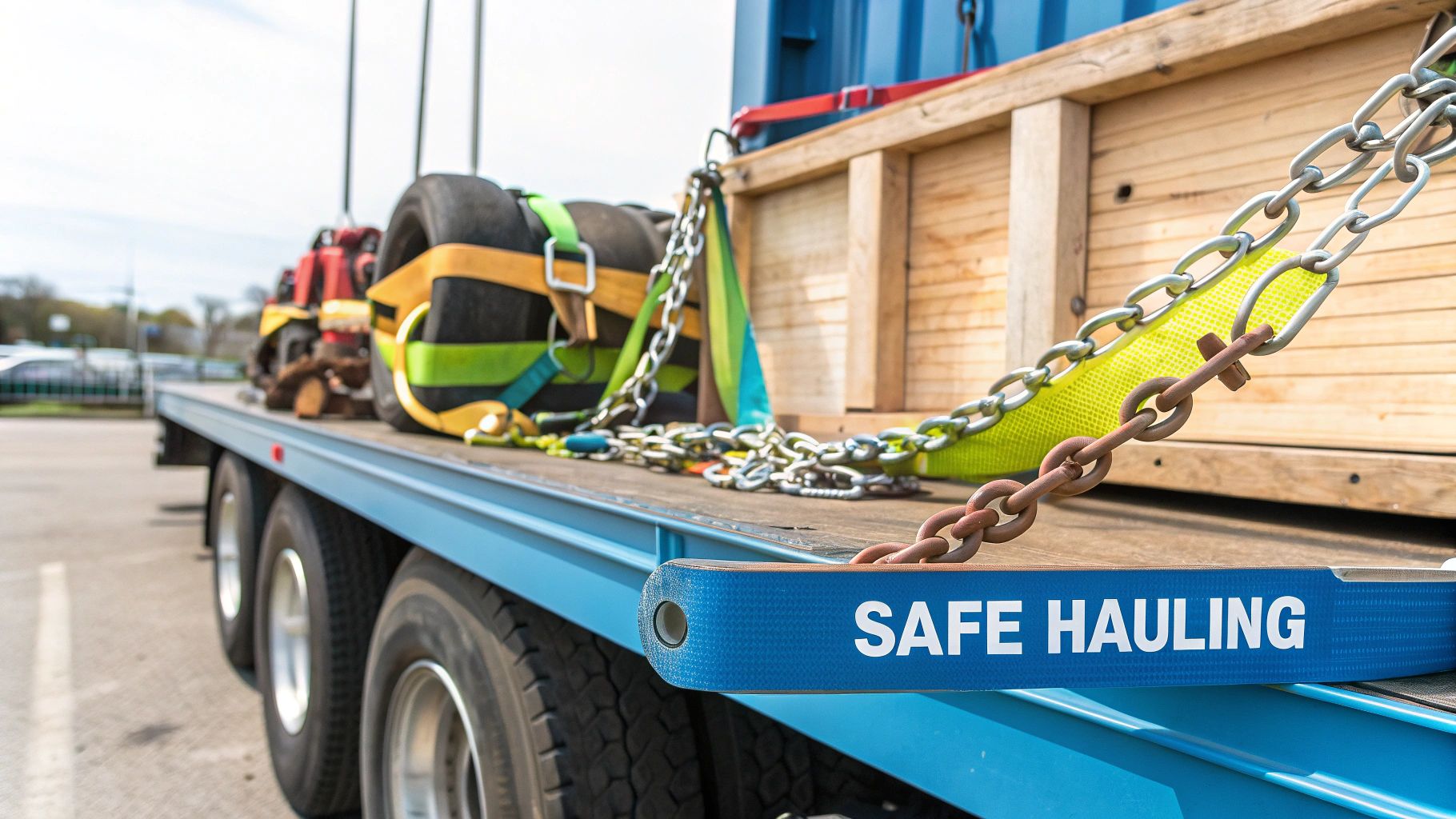
Successfully moving freight on an open deck trailer is a craft that blends precision, safety, and strategic planning. Unlike an enclosed van where walls provide containment, open transport puts all the responsibility on rock-solid technique and meticulous preparation. Mastering these best practices isn’t just about protecting the cargo—it’s about ensuring the safety of everyone on the road and delivering the shipment on time and without incident.
The cornerstone of any successful haul is proper load securement. This is far more than just throwing a few straps over the top. It’s about creating a single, immovable unit on the trailer deck using a system of specialized tools.
Each piece of securement equipment has a critical job to do, preventing the load from shifting, sliding, or tipping during transit. One miscalculation could lead to a catastrophic failure on the highway.
The Science of Proper Load Securement
You must think of your cargo and trailer as a single, cohesive system. The goal is to eliminate any chance of independent movement. This is achieved through the strategic use of dunnage, chains, straps, and protective gear.
- Dunnage: Often just lumber or blocks, dunnage is placed under and around cargo to create a stable base, distribute weight, and add friction to prevent sliding. It is a critical, yet often overlooked, component.
- Chains and Binders: For heavy, rigid loads like machinery or steel, chains are the primary tool. Tightened with binders, they create immense tension that locks the cargo directly to the trailer’s anchor points, preventing movement.
- Straps: For more delicate or finished surfaces where chains would cause damage, high-strength synthetic straps are used. They are versatile and ideal for securing everything from palletized goods to crated equipment.
- Corner Protectors: These simple devices are placed between the strap/chain and the cargo’s edge. They protect the cargo from being crushed by tension and prevent the strap itself from fraying or snapping under load.
Proper securement isn’t just a good idea—it’s a non-negotiable legal requirement. The forces acting on a load during acceleration, braking, and cornering are enormous. Only a correctly applied securement system can fight back against that physics.
For companies managing a whole fleet, understanding broader fleet management best practices is essential. These strategies help optimize maintenance, ensure everyone is compliant, and boost operational safety across the board.
Perfecting Weight Distribution
Just as important as securement is how you place the weight on the trailer. An unbalanced load makes the truck difficult to handle and can overload axles, leading to steep fines and unsafe driving conditions. The objective is to spread the weight evenly, staying within federal and state axle limits—typically 20,000 pounds on a single axle and 34,000 pounds on a tandem.
When a load is balanced correctly, the entire rig remains stable, brakes effectively, and handles predictably. This usually means positioning the heaviest part of the cargo directly over the trailer’s axle groups.
Advanced Cargo Protection and Route Planning
Once the load is secure and balanced, the final steps are protecting it from the elements and planning a smart route. Tarping is your first line of defense against rain, snow, and road grime. It’s a skill in itself, involving specific tarps (like steel or lumber tarps) and careful folding techniques to create a weatherproof seal that won’t flap in the wind—which can damage both the tarp and the cargo.
This industry is only getting bigger, driven by heavy hitters like agriculture and construction. In fact, the global open utility trailer market is projected to climb to $1.78 billion by 2035. This growth is fueled by a 62% demand from agriculture and a 48% jump in construction equipment transport. While challenges like rising steel costs are a factor, innovations in lightweight aluminum trailers and digital tracking are pushing the industry forward.
For oversized loads, route planning becomes absolutely critical. This is not about finding the fastest way from A to B. It requires a detailed survey of the entire journey to identify and plan for all obstacles. Shippers and carriers must verify bridge clearances, check for weight-restricted roads, and navigate tight turns. For specialized jobs, like moving vehicles, understanding the ins and outs of open transport car shipping offers valuable insights into those unique logistics.
By combining all these transport best practices—from meticulous securement and balanced loading to proactive protection and smart routing—you can ensure every open deck haul is safe, compliant, and efficient.
Got Questions About Open Deck Trailers? We’ve Got Answers.
Even after you’ve got the basics down, the real world of transport always throws a few curveballs. That’s why we’ve put together this quick-reference guide to tackle the most common questions that arise when booking an open deck trailer. Use this as a practical checklist for making smarter logistics decisions and avoiding costly delays.
Getting these details straight from the start is what makes the difference between a smooth haul and a logistical headache. Let’s dive into a few of the big ones.
What Is the Difference Between a Flatbed and a Step-Deck Trailer?
This is easily the most frequent question, and the answer all comes down to one critical factor: deck height. This single feature dictates what each trailer can legally and safely transport.
A standard flatbed trailer has a single, continuous deck that sits about 60 inches (or 5 feet) off the ground. Its design is ideal for general freight like lumber, steel beams, and any cargo that can be easily loaded from the side with a forklift.
A step-deck trailer (or drop-deck) is engineered differently. It has two deck levels: a short front deck and a much longer main deck that “steps down.” This main deck is significantly lower, usually around 36 to 40 inches high. This drop is the key—it allows you to haul taller items, often up to 10 feet high, without needing an over-height permit. This makes it the standard choice for transporting equipment like tractors or manufacturing machinery that would be too tall for a flatbed.
Is Tarping My Cargo on an Open Deck Trailer Necessary?
This decision depends entirely on your cargo’s durability. If your freight can handle exposure to weather and road grime, a tarp may not be necessary. Rugged materials like steel I-beams, concrete pipes, or heavy-duty construction equipment are built to withstand the elements.
However, if your freight is sensitive, tarping is an essential transport requirement. This includes machinery with exposed electronics, crated goods with cardboard packaging, or finished building materials that could be ruined by moisture or sun damage.
Think of a tarp as an insurance policy against the unpredictable. It’s a simple layer of protection that shields your valuable cargo from weather and road debris.
When you book your shipment, you must clearly state that a tarp is required. Carriers carry different types, like heavy-duty steel tarps or longer lumber tarps, and they need to bring the right equipment to protect your specific load.
How Do I Know If My Shipment Is Oversize?
Your shipment officially becomes “oversize” (or a “wide load”) the moment it exceeds standard legal dimensions. These rules can vary slightly by state, but the generally accepted federal limits are:
- Width: Anything over 8 feet 6 inches.
- Height: Any load that makes the total height (from the road to the top of your cargo) more than 13 feet 6 inches.
- Weight: When the total gross vehicle weight tops 80,000 pounds or exceeds specific axle weight limits.
If your shipment crosses any of these lines, it requires more detailed transport planning. You will need special permits, which often dictate travel routes, restrict travel to daytime hours, or even require pilot car escorts to ensure public safety.
This is why providing dead-on accurate dimensions and weight is the most critical information you can give your transport partner. It allows them to select the right trailer, secure all necessary permits, and plan a route that keeps your freight moving safely and legally.
Navigating the world of open deck transport takes experience and a sharp eye for detail. For over a decade, We Will Transport It has been the trusted expert in moving everything from heavy machinery to complex oversized loads across the country. Our logistics team manages every step—from trailer selection to permitting—to make sure your cargo gets where it needs to go, safely and on schedule. Ready to ship with an expert on your side? Get your free, no-obligation quote today and see how simple shipping can be.


